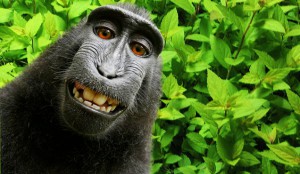Monkey Selfie Costs Photographer a Small Fortune
Monkey selfies are all fun and games until a photographer loses his paycheck for the year. In 2011, David Slater spent over 7,000 pounds (or $11,763) to travel to Indonesia to take pictures of crested black macaques. While on the scene, the monkeys stole his camera and took hundreds of pictures of themselves.
 One of those pictures turned out very well, but ended up in the hands of Wikimedia Foundation, the free information websites. Slater demanded Wikimedia take down the monkey selfie, but Wikimedia argued that the photo was in the public domain, not copyrighted.
One of those pictures turned out very well, but ended up in the hands of Wikimedia Foundation, the free information websites. Slater demanded Wikimedia take down the monkey selfie, but Wikimedia argued that the photo was in the public domain, not copyrighted.
Wikimedia’s argument is simple. The monkeys created the picture, but the animals have no property rights, so the picture belongs in the public domain. Normally, if a human owns an animal, then the human owns any property created by the animal. However, macaques are wild animals not owned by anyone.
Slater’s claim to the picture is that he invested a significant amount of money, time, and labor into getting the pictures, so he should be the photo’s rightful owner. Unfortunately for him, copyright law regarding photographs is that the person taking the picture is the “author” of the photo. Slater didn’t do anything to make the photo. Aside from having his camera stolen, Slater wasn’t involved in making the picture.
Slater could substantially modify the picture and claim the changes to the photograph make the picture his own work, but the picture’s value is the unimpeded view of the macaque (and the fact that the monkey took the picture herself). Also, even if he did modify the picture, Slater would only own the modified photo and not the original work.
Copyright law is supposed to promote the creation of new inventions or ideas though, so it makes little sense that labor and expenditure shouldn’t at least be a factor in determining who holds the copyright. The danger is that the distinction between investor and artist would be eroded if Slater held the copyright in this case.


Comments